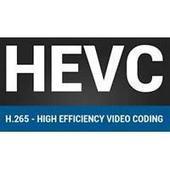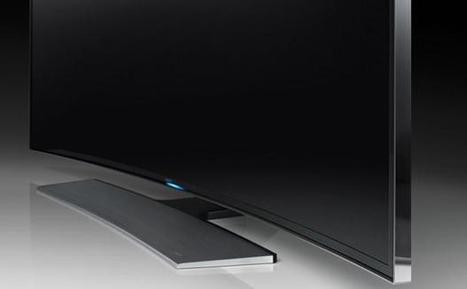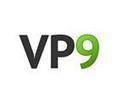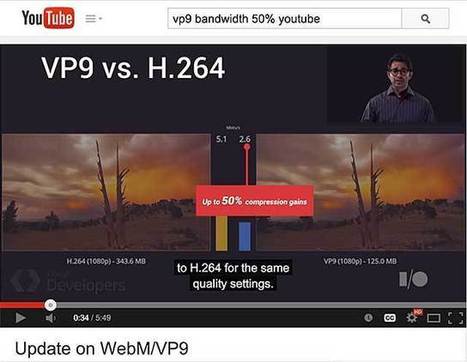 Your new post is loading...
 Your new post is loading...
Convert all your video to the latest and next generation video codec. The H.265 standard, able to produce same quality while reduce bandwidth up to 50%, which mean capable shrink half of original file size!
Using IFME allow to encode your media file into H.265 standard by using Open Source x265, with simple and friendly interface (GUI).
Also capable to encode and compress much more your lossless audio by using OpenCL acceleration!
This year the EBU BroadThinking Conference was sounding like a holistic swirl, a milestone in the trend of technology to define sets that are greater than the sum of their parts, through creative evolution. « Where Broadcast Meets BroadBand », you get some interesting fusion effect occurring and diluting the traditional boundaries of the screens, with the handheld devices being part of the big screen experience or extending it rather than trying to scalp it, in an environment where all the devices converge towards a restricted set of standards rather than tracing their own line.
While we by default think that standardization kills creativity, events like BroadThinking show that it’s the opposite: if we gather energies to solve common problems together, we can both come up with a more evolved solution and concentrate on what’s important past the pixel grid: the user experience, so consistent across screens that you forget there’s more than one screen involved.
The company's technical prowess and free VP9 licensing haven't been enough to dent the fortunes of rival compression format HEVC. But Google's already moving on to VP10.
DivX announced the release of the MainConcept® HEVC SDK 3.0. The newest release of the industry leading HEVC encoding tool includes support for real-time encoding of 1080p video at 30 frames per second.
Additionally, the release includes enhancements to the decoders available for PC and ARM, which adds weighted prediction, PCM decoding and Transquant Bypass to support playback on content from other party codec vendors.
The MainConcept HEVC SDK continues to make strides on encoding quality and performance, based on numerous in-house tests, currently realizing 35-48 percent bitrate improvements over H.264 (MainConcept H.264 v9.8 encoder) in internal company benchmark tests. What’s more, the included and patent-pending SABET™ (Smart Adaptive Bitrate Encoding Technology) achieved more than a 30 percent performance gain with transcoding adaptive formats such as DivX® HEVC adaptive streaming. This means companies interested in maximizing the efficiency of their applications, services and environments may reduce total encoding time for an adaptive stream by more than 30 percent by using SABET.
HEVC is among us. On January 25, 2013, the ITU announced the completition of the first stage approval of the H.265 video codec standard and in the last 1 year several vendors/entities have started to work on the first implementations of H.265 encoders and decoders. Theoretically HEVC is said to be from 30 to 50% more efficient than H.264 (especially at higher resolutions) but is it really that simple ? is H.264 so close to retirement ? This is what we will try to find. First of all let’s start with a technical analysis of H.265 compared to AVC and then, in the next blog post, we will take a look at the current level of performance that is realistic to obtain in today’s H.265 encoders.
H265 is a High Efficiency Video Coding player app for viewing HEVC/H.265 video files and network streams in the MKV video container format. H265 is based on the VLC library with added libde265 HEVC video decoding. In addition to HEVC/H.265 video other formats are also supported. (...)
Via Guillaume de Lafontaine
One of the world’s most famous performance institutions, the Vienna State Opera (VSO), is to stream what is claimed to be the world’s first live production in 4K video coding (HEVC). Delivered via MPEG-DASH over the Internet for global viewing on Samsung Smart TVs and on special public display in the opera house, the broadcast is set for 7pm CET on 7 May with a production of Verdi’s Nabucco starring Plácido Domingo in the title role will. It will be streamed for global viewing on UltraHD smart TVs as well as to a 65" Samsung UltraHD TV at the opera house.
Via DASH Industry Forum
At booth SU1210 at the 2014 NAB Show, Harmonic will demonstrate the world’s first end-to-end HEVC solution for delivering live 2160p60 10-bit Ultra HD content. In collaboration with companies including Broadcom Corporation, Sigma Designs, Vigor Systems, and ViXS, the Harmonic broadcast workflow supports the delivery of live, linear playout and VOD Ultra HD content to consumer-grade TVs and set-top boxes (STBs).
Highlights include: - The first consumer-grade demonstration showing live streaming of Ultra HD content, based on Harmonic’s market-leading HEVC encoding technology and the XCode 6400, a 2160p60 10-bit SoC chip from ViXS Systems, used to decode and display live content to a UHDTV via HDMI 2.0.
- An end-to-end solution for delivering 2160p60 Ultra HD VOD content over IP networks featuring Harmonic’s ProMedia® Xpress high-performance transcoder with HEVC support, sent by the WFS™ file-based workflow engine to a MediaGrid shared storage system, and streamed using the ProMedia Origin stream packager and server to consumer devices in the MPEG-DASH format.
- A 2160p60 Ultra HD linear playout workflow featuring Harmonic’s WFS, ProMedia Xpress, and MediaGrid solutions integrated with an Advertio transport stream playout platform from Vigor Systems, to deliver an Ultra HD linear channel.
- An Ultra HD 120-Hz broadcast workflow powered by Harmonic ProMedia Xpress frame-rate upconverted on Sigma Designs’ high-performance and cost-effective 120-Hz Ultra HD TV platform. Sigma Design’s Ultra HD TV platform is comprised of an Ultra HD TV SoC that enables HEVC decoding (STV7603) and an innovative motion judder removal and frame-rate conversion SoC (FRC8000) for providing the best picture quality on large screen displays.
- The first standard-compliant live 4K Ultra HD broadcast workflow, powered by Harmonic ProMedia Xpress transcoding and decoded by Broadcom’s BCM7445 Ultra HD video decoder solution.
While few companies of any kind are actually making money from HEVC (H.265) today, the successor to H.264 will become increasingly important during the next 2–3 years, perhaps even earlier in some markets for some producers. So understanding the current status of the technology and how to encode and potentially deploy HEVC in the near term is very relevant for most streaming media producers. Accordingly, in this article, I’ll review the state of HEVC and take a high-level look at the first generation of HEVC encoders.
While online video providers will be able to pioneer 4K viewing for the public using bit rates as low as 10Mbps (for movies over broadband), the introduction of true Ultra High Definition (UHD) television on broadcast networks will start at around 15Mbps, while we could see bit rates as high as 30Mbps initially, using the best current available HEVC/H.265 compression.
Although consumer marketing is confusing the two, there is a big difference between 4K television, which delivers four times the pixels of HDTV, and what is being talked about as true UHD, which quadruples the pixel count but also supports at least 50/60 frames per second and at least 10 bit colour depth.
NTV Plus pioneered the initiative to broadcast the Sochi 2014 Winter Games in 4K. Following an extensive period of testing during 2013, NTV Plus designed and deployed an end-to-end 4K HEVC workflow that features Sony 4K cameras, Elemental Live video encoders, NTV Plus satellite uplink and signal receiving systems and Broadcom-enabled real-time decoders for playback on Panasonic 4K TVs. A single video stream encoded by Elemental enables NTV Plus to reduce the 100Mb of bandwidth which would otherwise have been required for delivery of 4K HEVC content.
Alors que l'on évoquait il y a quelques jours les tests menés par la NHK au Japon sur la diffusion hertzienne de flux vidéo en 8K (et réussis sur une distance de 27 Km), on apprend aujourd'hui que l'équipementier Broadcom est, en partenariat avec l'opérateur scandinave Teracom, parvenu à diffuser un flux vidéo en 2160p (sans doute de l'Ultra HD en 3840 x 2160) via le codec HEVC (ex-H.265) en exploitant la technologie DVB-T2 (une évolution du DVB-T utilisé pour notre TNT).
Norme DVB-T2 qui devrait, logiquement, être choisie pour la future TNT2, tandis que malgré les tentatives de Google d'imposer son codec VP9, l'industrie devrait se tourner massivement vers le HEVC pour la compression des flux vidéo Ultra HD à l'avenir. HEVC qui permet, gross modo, de diviser par deux la bande passante nécessaire pour la diffusion d'un flux vidéo de qualité identique par rapport à l'actuel H.264. Soit un précieux allié pour ne pas voir la taille des fichiers trop exploser lors du passage à l'Ultra HD.
|
HEVC might be getting all the attention, but Google's VP9 appears to match H.265 in quality and might play a bigger role in the transition from Flash to HTML5
Ittiam Systems is pleased to announce its bringing the power and scale benefits of the advanced High Efficiency Video Coding (HEVC / H.265) technology to the mass market. Ittiam worked over the last several months to bring native HEVC Decode to Android, by way of the standard’s inclusion in the Android Media Framework, within Android 5.0, Lollipop.
HEVC/H.265 burst onto the scene in January 2013, when it was released for production by the two standards bodies that helped create it, the International Telecommunication Union (ITU) and Moving Picture Experts Group (MPEG). Now, about 18 months after its release, how usable is HEVC? Well, actually, not very. This article will look at HEVC’s status in three segments: delivery to computers and notebooks, to mobile, and to OTT, identifying the trends and value propositions affecting each market.
NGCodec was at the JCT-VC/MPEG Meeting in Sapporo to help the industry to continue with the development of the HEVC standard. This was a busy meeting where we did substantial work over 9 days. JCT-VC finished the work on the 2nd version of the HEVC text covering the enhancements related to scalability (SHVC), completed the work on HEVC Test Model (HM15) software and text, the version 1 conformance and accelerated the work in relation to the coding of screen content (SCC). They were a number of additional MPEG activities that were conducted outside JCT-VC, mostly in relation to High Dynamic Range video (HDR) and royalty free codecs.
The BBC has started its Ultra-HD closed trials from the World Cup tournament in Brazil. The BBC Research & Development department has partnered with Arqiva for the trials that will use the latest DVB-DASH profile IP. The UHD production will be received in the UK from an H.264/AVC satellite contribution feed. For both DTT and IP we will be using Main Profile HEVC to compress the video to distribution bitrates that can be sustained within a DVB network and a super-fast broadband line. The frame rate being used is 59.94Hz as that is the standard in Brazil. The DTT trial will be transmitted from Crystal Palace (London), Winter Hill (Manchester) and Black Hill (Glasgow). The transmissions are just starting up now. As we are using the same T2 modulation parameters that are used for HD multiplexes the signal can be received on current consumer equipment, I’m not aware of any equipment which can decode the video. Though some existing HD models may tune the service and decode the audio. The stream will use the latest DVB-DASH profile and is geo-IP locked to the UK only.
Via DASH Industry Forum
New version of the HEVC/H. 265 codec offers high quality at extremely low-bandwidth video streaming The free video codec libde265 is now available in version 0.7. libde265 is based on the video compression technology HEVC and allows a 50-percent reduction of bit rates with the same image quality. As libde265 without special hardware, video streams can be in H. 265 quality play easily on mobile devices (smartphones and tablets). So, you can greatly reduce bandwidth costs for streaming and network. In addition, ultra HD includes much more than just four times the resolution to full HD. The color space and color resolution are also significantly larger — benefits the presentation at the 4K-TV regardless of pixel resolution the better dynamic range and is considered by companies in the consumer electronics industry as a driver for the next generation. With the standard-compliant version libde265 0.7, the speed has been improved up to a factor of 2. Framedropping and flexibility the frame rate also high-resolution video images even on slower processors are possible. (...)
Via Guillaume de Lafontaine
Vantrix today officially launched their open source HEVC project website, f265.org. The f265 project was previously announced as an open source version of the H.265 encoder, also known as High Efficiency Video Coding (HEVC). The project aims to accelerate the industry-wide development and adoption of H.265 through a collaborative and free open source model. The project website is now officially available for researchers and commercial entities to obtain the source code and contribute to the refinement and evolution of the code to accelerate the implementation of both software and hardware systems.
Vantrix’s f265 encoder will be licensed under the OSI BSD terms, enabling access to source code, free redistribution, and derived works. The project will target both high quality offline and real-time encoding.
“The f265.org site is maintained by and for developers to help accelerate the development and adoption of HEVC,” noted Francis Labonte, Vantrix research lab director. “We have a working baseline version available that we’ve been demonstrating for UHD/4k live streaming and now want to take the real-time performance and feature set to the next level. We’re hoping to contribute to accelerating the industry transition from H.264 to H.265 and solving network bandwidth issues for high definition video.”
NanoTech Entertainment announced today that it has partnered with Ittiam Systems Ltd. to provide NanoTech's Nuvola NP-1 and NP-C consumer and commercial 4K Ultra HD streaming media players with HEVC (H.265) and VP9 support. NanoTech will join Ittiam in providing demonstrations of the newly enhanced players at Ittiam's NAB 2014 Booth SU11021 (Upper South Hall).
The demonstrations will show how Ittiam's Tegra-4 optimized 4K HEVC decoder running on Nuvola can effectively enable anyone with a 3 Mbps or greater pipe to stream 4K content to their Ultra HD TV. NanoTech's own 4K OTT Video Service, UltraFlix, along with the likes of Amazon, Netflix, YouTube and M-GO will all be able to stream amazing quality content to Nuvola customers at lower bit-rates than ever before.
The demonstration will be streaming DivX HEVC UltraHD (4K) video to a 4K TV set. The MPPA-256 , KALRAY’s first MPPA® MANYCORE processor coming with 256 cores on a single chip, will be used for a demonstration at CCBN 2014, being held in Beijing, China (Mar 20-22). The MPPA-256 processor demonstrates a complete Ultra HD HEVC live encoding based on DivX HEVC UltraHD video.
Kalray’s demnonstrator uses the MainConcept HEVC SDK that is capable of encoding a high-quality Ultra HD HEVC video at 30 fps using four MPPA®-256 processors which consume less than 50 Watts altogether. The decoding and live display will be shown on a commercially available Ultra HD TV.
FFmpeg and its forked Libav have each added an H.265 / HEVC encoder today to their respective code-bases.
Going back to the middle of last year there's been the open-source x265 project for implementing the High Efficiency Video Coding (HEVC) video format that succeds H.264/MPEG-4 AVC. We have also seen open-source HEVC / H.265 support come via libde265 as a decoder for this video format that doubles the data compression ratio of H.264 while at the same video quality level.
Ace Thought Technologies, a leading provider of media processing software, today announced the release of highly optimized, multi-threaded, power efficient and real-time H.265/HEVC software video decoder for ARM Cortex-A series and x86 processors. Ace Thought’s HEVC video decoder software enables rich entertainment experience across smart-phones, tablets, set-top boxes, smart TVs and connected devices.
Ace Thought’s HEVC video decoder for ARM processor provides scalable performance by utilizing ARM NEON SIMD and multi-core processor technologies. The HEVC video decoder is scalable up to 8 cores and enables 60 fps playback of 1080p HD resolution content on quad-core ARM Cortex-A15 processor. Ace Thought’s HEVC video decoder software enables the creation of high-quality player application on existing Android, iOS and Windows Phone 8 based tablets and smart-phones.
|
 Your new post is loading...
Your new post is loading...
 Your new post is loading...
Your new post is loading...







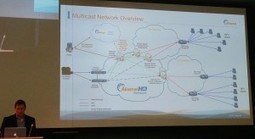


![H265 - part I : Technical Overview [Fabio Sonnati] | Video Breakthroughs | Scoop.it](https://img.scoop.it/jHvhgpIdqFIPjdCyyymDrTl72eJkfbmt4t8yenImKBVvK0kTmF0xjctABnaLJIm9)


